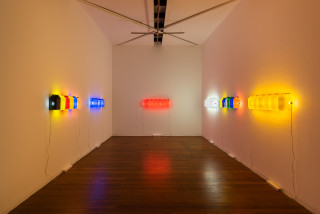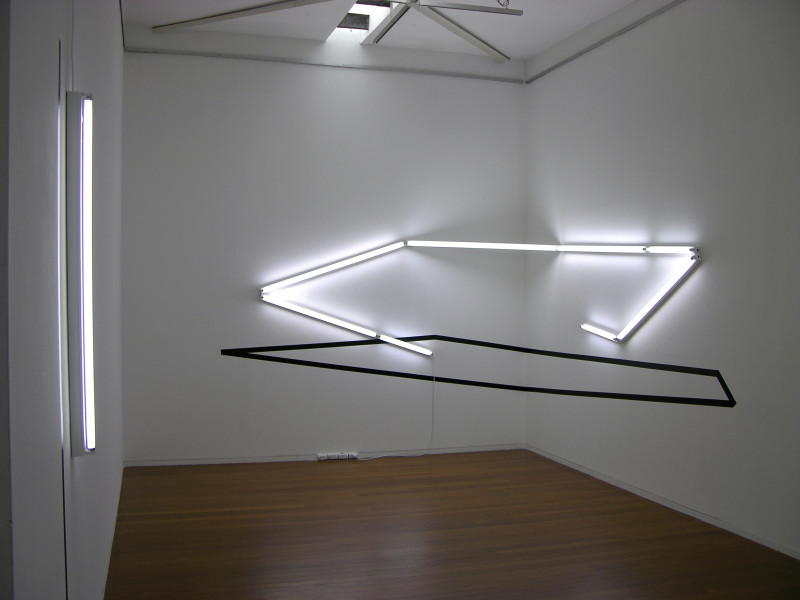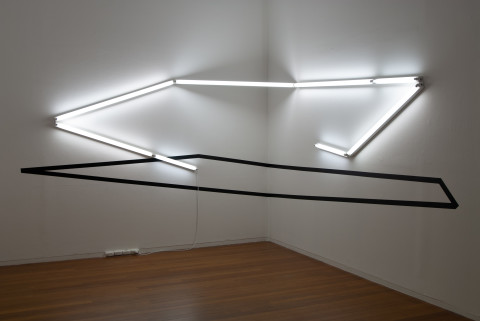In this exhibition, Culbert uses the three-dimensional form of fluorescent lights and flat, matt-black lines to highlight the often unquestioned relationship between black and light—where they are viewed as endpoints to each other, extreme opposites, rather than being part of the same visible realm.
Exhibition Dates: 2 May – 27 May 2006
Light is a sensate thing—it is felt as much as seen. We learn that the achromatic colours—white, grey and black—represent the relationships between surface, depth and shape. Hues model an object—the contours equate to a conceptual truth that a material thing exists in the same three-dimensional world that our bodies occupy.
Our modern understanding of colour is largely owed to Isaac Newton, who discovered the spectral nature of light via his experiments with prisms (in 1617 he used the word ‘spectrum’ from the Latin, meaning “appearance” or “apparition”). Until Newton’s work in optics became accepted, most scientists believed that white was the fundamental colour of light; and that the other colours were formed only by adding something to light. Newton’s experiments revealed that white light was in fact formed by the combination of colours in the familiar rainbow spectrum classed as visible light.
The achromatic colours—white, grey and black—are perceived when an equal amount of each colour (wavelengths and frequency and of light) are incident on a surface which either reflects, scatters or absorbs. White is perceived when all visible light is reflected back from a surface, and black can be defined as “the visual impression experienced in directions from which no visible light reaches the eye.”1 That is, when pigments absorb all visible light.
In Black and Light, Bill Culbert examines the schism between seeing and the trustworthiness of our sense perceptions. The metaphysical issues that concern how we understand the nature of reality underpin the artist’s work to date. In this exhibition, Culbert uses the three-dimensional form of fluorescent lights and flat, matt-black lines to highlight the often unquestioned relationship between black and light—where they are viewed as endpoints to each other, extreme opposites, rather than being part of the same visible realm.
2-stroke (black and light) throws the wall off balance. The suspended light relates to the black line in terms of a series of artistic choices—what is the effect of changes in length, material, angle, depth? Or, how do you draw with materials in space, as much as negotiate sculptural objects? In Culbert’s art, black is not only the possibility of shadow. In adherence to the wall, the nature of black becomes suspect; flat, emanating, or void?
A large polygon constructed of fluorescent light and industrial casings, in Right-angle (black and light), straddles the corner of the gallery. The work overall appears to hover in the gallery space, and privileges the intersection of the wall, the corner, as the connection between two possible axes. At odds with this perception is the way in which the light casings appears to cling to the wall. Culbert severs the easy mirroring of the light-shape from the black lines we might read as a shadow. It is an entity that activates the gallery space on its own terms. The angles at which these components may correspond must be imagined, and this conception of an angle is as much part of the work as the physical object itself.
—Naomi Evans
1 http://en.wikipedia.org/wiki/Black
—
Bill Culbert has been exhibiting his sculptures and photographs in the , Europe, , and for over forty years. A major exhibition of his work was held by City Gallery Wellington in 1997. Culbert was included in Toi Toi Toi: 3 Generations of New Zealand Art at the Art Museum Fredericianum in Kassel in 1999 and in the 1990 Biennale of Sydney (curated by Renee Block). In 2002 he exhibited in the Second Asia-Pacific Triennial with a joint work with Ralph Hotere (with whom Culbert has done a number of collaborative works). Culbert has completed numerous major public commissions, recent examples include a large neon work for the PriceWaterhouseCoopers Tower in Auckland, and Skyline for the Millenium Dome in London. Since 1957, Culbert has divided his time between London and . Black and Light is the artist’s second solo exhibition at Roslyn Oxley9 Gallery.
 Group Show, The First 40 Years
Group Show, The First 40 Years
Roslyn Oxley9 Gallery, 2024
 Bill Culbert
Bill Culbert
Roslyn Oxley9 Gallery, 2021
 Bill Culbert Time Tables
Bill Culbert Time Tables
Roslyn Oxley9 Gallery, 2018
 Group Show, State of Play
Group Show, State of Play
Roslyn Oxley9 Gallery, 2017
 Group Show
Group Show
Roslyn Oxley9 Gallery, 2016
 Bill Culbert Central Station, The Return
Bill Culbert Central Station, The Return
Andata Ritorino, Geneva, 2016
 Bill Culbert
Bill Culbert
Musee des Beaux-Arts de Dole, France, 2015-16
 Group Show, Light Show
Group Show, Light Show
Museum of Contemporary Art Australia, Sydney, 2015
 Bill Culbert
Bill Culbert
National Art School, Sydney, 2015
 Bill Culbert Light Levels
Bill Culbert Light Levels
Chateau des Adhemar, Centre d'Art Contemporain, Montelimar, France, 2014
 Bill Culbert Front Door Out Back
Bill Culbert Front Door Out Back
55th Venice Biennale, 2013
 Group Show, Groups Who
Group Show, Groups Who
Roslyn Oxley9 Gallery, 2011-12
Bill Culbert State of Light
PEER, London, 2009
 Bill Culbert Flat Light
Bill Culbert Flat Light
Roslyn Oxley9 Gallery, 2009
 Group Show, Lucky Town
Group Show, Lucky Town
Roslyn Oxley9 Gallery, 2008-09
Bill Culbert Groundworks
Govett-Brewster Art Gallery, New Plymouth, New Zealand, 2008
 Bill Culbert Black and Light
Bill Culbert Black and Light
Roslyn Oxley9 Gallery, 2006
Bill Culbert Coup de Foudre
Canary Wharf Estate, London, 2006
Bill Culbert SkyBlues
Jervois Quay, Wellington, New Zealand, 2006
 Bill Culbert Daylight and Nightlight
Bill Culbert Daylight and Nightlight
Roslyn Oxley9 Gallery, 2004
Bill Culbert Wine, Light, and Things
Millenium Gallery, Blenheim, New Zealand, 2003
Bill Culbert Skyline
Millennium Dome, London, 2000
Bill Culbert Skylight IV (with Ralph Hotere)
Viaduct Basin, Auckland, 2000
Bill Culbert Blue Cloud
BUPA, London, 1997
Bill Culbert Inside Out
Serpentine Gallery, London, 1996
Bill Culbert Light Column/Cabbage Tree
Gibbs Art Farm, Auckland, 1996
Bill Culbert Fault (with Ralph Hotere)
City Gallery Wellington, New Zealand, 1994



